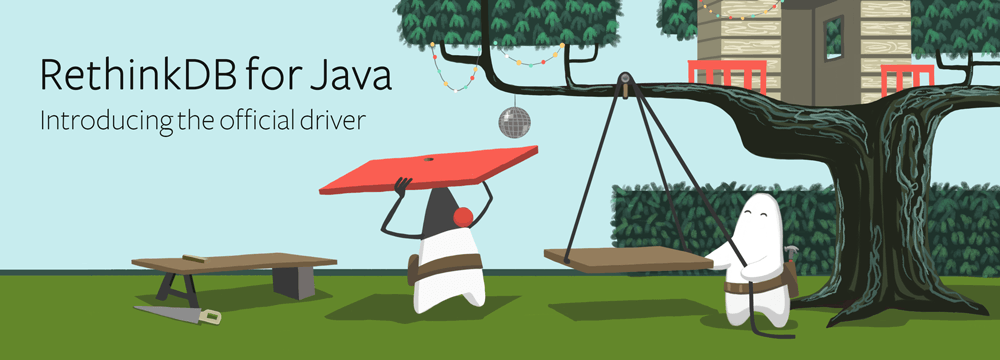
Introducing the official RethinkDB Java client driver
Today, we’re pleased to announce the release of our Java client driver for RethinkDB. Visit the installation instructions for details about how to use it in your Java project.
With this release, we now officially support Java for RethinkDB application development, alongside Python, Ruby, and JavaScript. The Java client driver is fully-featured. It’s built on RethinkDB’s modern JSON wire protocol and supports the latest capabilities introduced in RethinkDB 2.2. It is designed for use with Java 8 because it uses the language’s shiny new anonymous function syntax to deliver the expressiveness that developers expect from ReQL.
The client driver is a library that implements RethinkDB’s ReQL query language and provides support for connecting to a RethinkDB cluster. Java developers can use RethinkDB to build realtime web applications. You can perform queries and receive live updates as the output changes.
Why support Java?
Java is a well-established language with a large enterprise presence. It’s also currently in a cycle of renewal, with healthy external innovation and a roadmap that promises modernization. Alt-JVM languages are popularizing functional programming idioms and more expressive approaches to programming. Java developers are also increasingly interested in reactive and event-driven programming models, influenced by the introduction of native streams in Java 8 and growing adoption of third-party libraries like RxJava and Vert.x. We think that RethinkDB’s approach to data persistence and realtime application development–pushing live updates to the frontend–are a great fit for Java as developers chart the frontiers of these emerging trends.
We’re also excited that bringing RethinkDB to Java will unlock support for the vibrant ecosystem of other languages that target the Java virtual machine. Our native client driver will serve as a starting point for developers who want to use RethinkDB in other popular languages like Scala, Clojure, and Groovy. You can look forward to a follow up blog post next week with some hands-on examples in those languages.
Just a sip: building a demo application
The Java client driver exposes largely the same method-chaining API that we provide today in other languages. This is what a simple ReQL query looks like in Java:
RethinkDB r = RethinkDB.r;
Connection conn = r.connection()
.hostname("localhost").port(28015).connect();
// Find the odd numbers, multiply each by 2, and add the total
Long output = r.range(10)
.filter(x -> x.mod(2).eq(1))
.map(x -> x.mul(2)).sum().run(conn);
To give you an idea of how the Java client driver might work in a real world application, I built a simple chat application with a web frontend. I built the backend with Vert.x, a Java framework that is well-suited for realtime web applications.
Vert.x applications are composed of microservices, each implemented in a class called a Verticle. The framework provides a built-in event bus that you can use to pass messages between verticles. The Vert.x event bus also has a WebSocket bridge, implemented on top of SockJS, that you can use to propagate messages between the frontend and the backend.
In my demo application, I have a simple HTTP POST endpoint that the frontend client application can use to send a message. The handler for the endpoint inserts the message into a RethinkDB table:
Vertx vertx = Vertx.vertx();
Router router = Router.router(vertx);
router.route(HttpMethod.POST, "/send").handler(BodyHandler.create());
router.route(HttpMethod.POST, "/send").blockingHandler(ctx -> {
JsonObject data = ctx.getBodyAsJson();
if (data.getString("username") == null ||
data.getString("text") == null) {
ctx.response
.setStatusCode(500)
.putHeader("content-type", "application/json")
.end("{\"success\": false, \"err\": \"Invalid message\"}");
return;
}
Connection conn = null;
try {
conn = r.connection().connect();
r.db("chat").table("messages").insert(
r.hashMap("text", data.getString("text"))
.with("username", data.getString("username"))
.with("time", r.now())).run(conn);
ctx.response()
.putHeader("content-type", "application/json")
.end("{\"success\": true}");
}
catch (Exception e) {
ctx.response()
.setStatusCode(500)
.putHeader("content-type", "application/json")
.end("{\"success\": false}");
}
finally {
conn.close();
}
});
router.route().handler(StaticHandler.create().setWebRoot("public"));
vertx.createHttpServer().requestHandler(router::accept).listen(8000);
When implementing a Vert.x route handler, you can optionally use the
blockingHandler method, which tells Vert.x to use its thread pool to execute
the anonymous function in the background. This feature is useful when
performing RethinkDB queries with the Java client driver, since the queries are
executed synchronously.
Now that the POST endpoint is implemented, we need to attach a changefeed to the table and monitor for new records. When the application detects that there’s a new message in the table, it should broadcast the message over the Vert.x event bus:
EventBus bus = vertx.eventBus();
router.route("/eventbus/*").handler(
SockJSHandler.create(vertx).bridge(
new BridgeOptions().addOutboundPermitted(
new PermittedOptions().setAddress("chat"))));
new Thread(() -> {
Connection conn = null;
try {
conn = r.connection().connect();
Cursor<HashMap> cur = r.db("chat").table("messages").changes()
.getField("new_val").without("time").run(conn);
for (HashMap item : cur)
bus.publish("chat", new JsonObject(item));
}
catch (Exception e) {
System.err.println("Error: changefeed failed");
}
finally {
conn.close();
}
}).start();
To set up the event bus, you have to bind it to a URL route (in this case
/eventbus) and then configure the permissions so that the outbound chat
messages are made accessible to frontend clients. Vert.x lets you use arbitrary
strings to define event bus addresses, which you can use to distinguish
different kinds of messages. You can configure separate permissions for each
address.
In your frontend web application, you can use the JavaScript-based Vert.x event
bus client library to handle the incoming messages and display them to the
user. In the code below, I use the registerHandler method to subscribe to
messages that the backend broadcasts to the “chat” address:
var bus = new vertx.EventBus("/eventbus");
bus.onopen = function() {
bus.registerHandler("chat", function(message) {
console.log("Received message:", message);
});
}
In my demo application, I use the lightweight Vue.js framework which lets me take advantage of simple data binding to present messages to the user. I can simply append new incoming messages to an array and let the framework add them to the view. You can, however, just as easily use alternatives like React or Angular. You can see the complete demo application source code on GitHub.
How the RethinkDB Java client driver differs from other languages
The Java client driver includes a number of convenience mechanisms that make
ReQL work well in Java’s statically-typed environment. For example, the driver
includes special r.array and r.hashMap methods that you can use to
instantiate hashes and lists. The r.hashMap method is often useful when
assembling JSON objects to insert into the database:
r.table("fellowship").insert(r.array(
r.hashMap("name", "Frodo").with("species", "hobbit"),
r.hashMap("name", "Sam").with("species", "hobbit"),
r.hashMap("name", "Merry").with("species", "hobbit"),
r.hashMap("name", "Pippin").with("species", "hobbit"),
r.hashMap("name", "Gandalf").with("species", "istar"),
r.hashMap("name", "Aragorn").with("species", "human"),
r.hashMap("name", "Boromir").with("species", "human"),
r.hashMap("name", "Legolas").with("species", "elf"),
r.hashMap("name", "Gimili").with("species", "dwarf")
)).run(conn);
r.table("fellowship")
.filter(r.hashMap("species", "hobbit"))
.update(r.hashMap("species", "halfling")).run(conn);
Instead of optional named arguments, we introduced a special optArg method
that you can append to a query to specify the settings for a particular query
command. In the following example, we’ve chained an optArg method after the
between command to specify the bound behavior:
r.table("marvel")
.between(10, 20).optArg("right_bound", "closed").run(conn);
Much like the JavaScript driver, the Java driver uses methods for operations
like addition, subtraction, multiplication, and equality checks. We also added
a shorthand method called g that you can use to retrieve the value of a
specific field, comparable in behavior to the bracket index access syntax that
you’d use in Python.
r.table("fellowship")
.filter(x -> x.g("species").eq("human")).count().run(conn)
RethinkDB changefeeds work out of the box, invoked with the standard changes
command. You can iterate over the cursor with a conventional for loop:
Cursor<HashMap> cur = r.table("fellowship").changes().run(conn);
for (HashMap item : cur)
System.out.println(item);
When you execute a ReQL query with the Java client driver, the operation is performed synchronously. At the present time, you will generally have to handle threading yourself if you want to perform the queries in a non-blocking manner. Connection instances aren’t thread-safe by design, so you’ll want to create a separate RethinkDB connection per thread.
A behind the scenes look at how we brewed the Java driver
We designed ReQL to provide a good developer experience, with a fluent API that feels a lot like the kind of abstractions that you get from ORMs and query builder libraries. The downside is that it often takes a lot of highly repetitive code to support method chaining and the wide range of commands included in the query language.
Josh Kuhn, the RethinkDB engineer behind the Java driver, came up with a delightfully esoteric way to simplify the development process. He created a Python script that parses the ReQL protocol specification and uses the information to automatically generate much of the boilerplate–including the code that implements the individual ReQL commands and translates chained expressions into the equivalent wire protocol representation.
We’ve released the scripts and templates as open source alongside the Java client driver itself. If you’d like to see how the automation works, you can check out the metajava.py script in the RethinkDB GitHub repository. It uses the popular Python-based Mako templating engine to generate the actual Java source code files. The complete Mako templates are also available on GitHub. You can see the template output in the gen directory, where there’s a separate Java file for each class that represents an individual ReQL command.
Now that we’re releasing this code, we look forward to seeing how the RethinkDB community puts it to use. You could, for example, write your own templates and adapt it to generate code for a different programming language. If you are interested in building a RethinkDB client driver, you might want to take a look and consider if it can help. We’ve already seen at least one promising effort emerge from the community: developer Brian Chavez is porting the Java driver to C#, using Razor templates for the automatic code generation.
Of course, it’s not possible to automate everything. We still had to write several key pieces of the Java driver by hand, including the code to parse responses and the network code that facilitates communication with a RethinkDB cluster. The automation was, however, tremendously helpful in achieving full ReQL coverage.
Next steps
If you’d like to build a Java application with RethinkDB, check out our installation instructions and the ten-minute guide to learn more about using RethinkDB in Java. To explore the ReQL query language, visit the API documentation.
 Ryan Paul
Ryan Paul